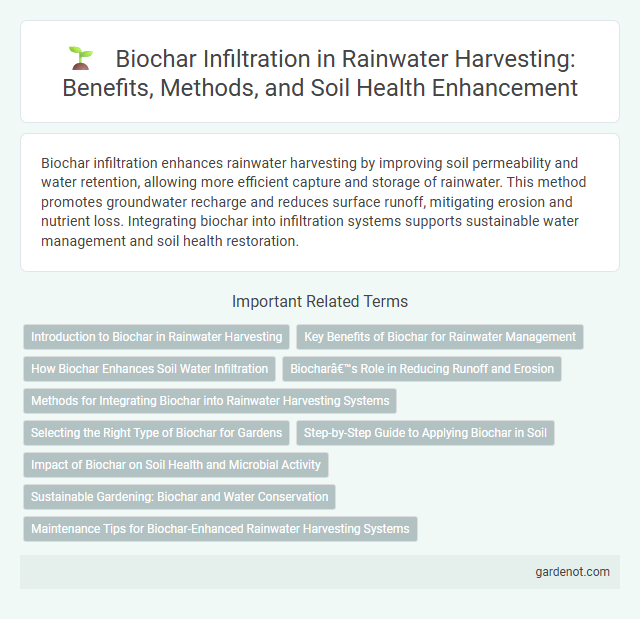Biochar infiltration enhances rainwater harvesting by improving soil permeability and water retention, allowing more efficient capture and storage of rainwater. This method promotes groundwater recharge and reduces surface runoff, mitigating erosion and nutrient loss. Integrating biochar into infiltration systems supports sustainable water management and soil health restoration.
Introduction to Biochar in Rainwater Harvesting
Biochar enhances rainwater harvesting by improving soil infiltration and water retention through its porous structure and high surface area. Its ability to adsorb nutrients and contaminants supports healthier plant growth and reduces runoff pollution. Integrating biochar into rainwater harvesting systems increases groundwater recharge efficiency and promotes sustainable water management.
Key Benefits of Biochar for Rainwater Management
Biochar significantly enhances rainwater management by improving soil infiltration rates and increasing water retention capacity, which reduces surface runoff and mitigates flood risks. Its porous structure promotes microbial activity and nutrient retention, leading to healthier vegetation and stronger root systems that further stabilize soil. Incorporating biochar into rainwater harvesting systems optimizes groundwater recharge and supports sustainable water conservation practices.
How Biochar Enhances Soil Water Infiltration
Biochar enhances soil water infiltration by increasing soil porosity and improving aggregate stability, which allows rainwater to penetrate more efficiently into the ground. Its high surface area and porous structure facilitate better water retention and slow release, reducing runoff and promoting deeper moisture infiltration. Incorporating biochar into soil also boosts microbial activity, which further improves soil structure and water absorption capacity.
Biochar’s Role in Reducing Runoff and Erosion
Biochar enhances soil structure and increases water retention capacity, effectively reducing surface runoff and minimizing erosion in rainwater harvesting systems. Its porous nature improves infiltration rates, allowing more rainwater to percolate into the soil rather than flowing away. Incorporating biochar in infiltration basins or trenches stabilizes soil particles and supports vegetation growth, which further mitigates erosion risks.
Methods for Integrating Biochar into Rainwater Harvesting Systems
Biochar infiltration in rainwater harvesting systems enhances water retention and improves soil quality by increasing porosity and microbial activity. Methods for integrating biochar include direct mixing with soil in infiltration basins, layering biochar within permeable trenches, and incorporating biochar-amended compost into rain gardens. These approaches optimize rainwater filtration, reduce runoff, and promote sustainable groundwater recharge.
Selecting the Right Type of Biochar for Gardens
Selecting the right type of biochar for garden rainwater harvesting depends on factors such as feedstock source, particle size, and porosity, which influence water retention and nutrient adsorption capabilities. Hardwood-derived biochar with a fine-to-medium particle size is preferred for optimizing infiltration rates and enhancing soil moisture retention. High-porosity biochar increases microbial activity and nutrient availability, improving overall garden soil health and water efficiency.
Step-by-Step Guide to Applying Biochar in Soil
Applying biochar to soil begins with selecting high-quality, nutrient-rich biochar to maximize water retention and microbial activity. Spread the biochar evenly across the rainwater harvesting site, then till it into the top 15-20 cm of soil to enhance infiltration and soil structure. Maintain moisture levels post-application to encourage biochar integration and optimize rainwater absorption and storage.
Impact of Biochar on Soil Health and Microbial Activity
Biochar infiltration significantly improves soil health by enhancing nutrient retention and increasing water holding capacity, leading to more resilient soil structure. The porous nature of biochar provides an ideal habitat for beneficial microbes, boosting microbial activity and promoting nutrient cycling. This synergistic effect enhances plant growth and supports sustainable rainwater harvesting systems by maintaining soil fertility and reducing runoff.
Sustainable Gardening: Biochar and Water Conservation
Biochar infiltration enhances rainwater harvesting by improving soil structure and increasing water retention, crucial for sustainable gardening. Its porous nature reduces runoff and promotes deeper water percolation, conserving water resources effectively. Integrating biochar into garden soils supports drought resilience and nutrient cycling, fostering eco-friendly water management.
Maintenance Tips for Biochar-Enhanced Rainwater Harvesting Systems
Regular inspection of biochar infiltration systems is crucial to prevent clogging and ensure optimal water permeability in rainwater harvesting setups. Periodic removal of accumulated sediments and replenishment of biochar layers maintain infiltration efficiency and support microbial activity essential for water purification. Implementing scheduled maintenance extends system lifespan and enhances rainwater recovery by sustaining biochar's adsorption capacity and structural integrity.
Biochar infiltration Infographic

 gardenot.com
gardenot.com